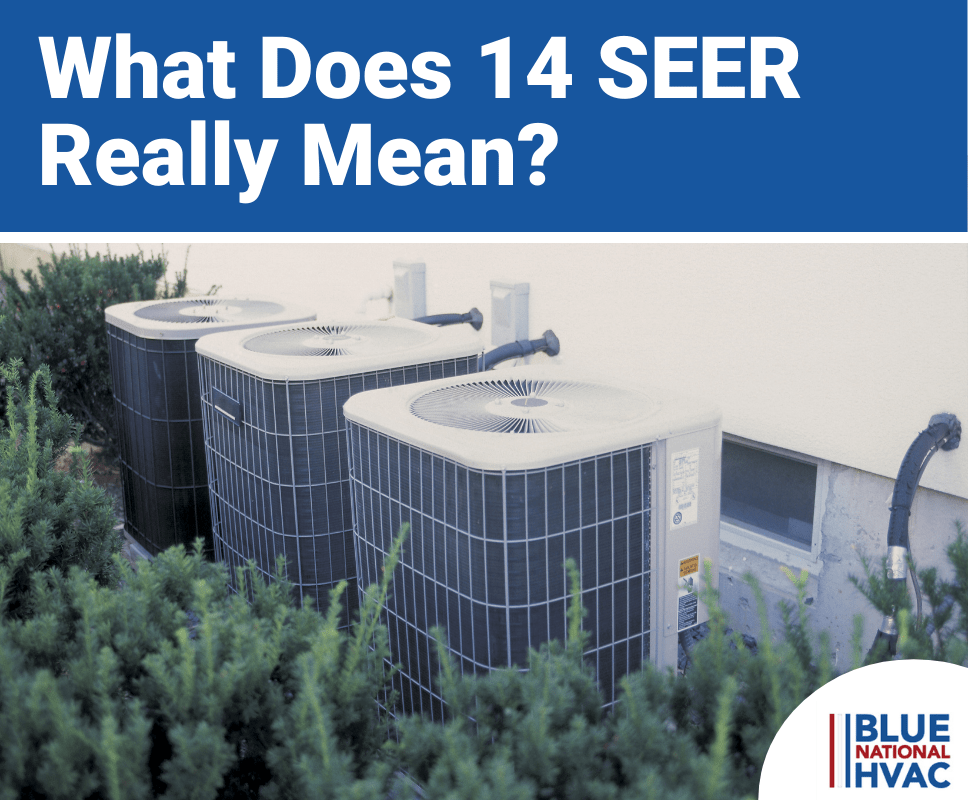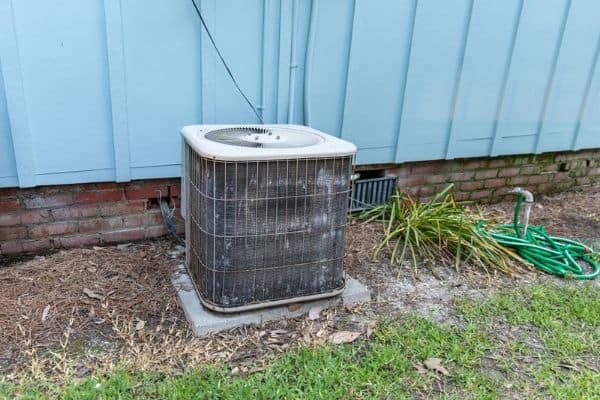What Do SEER Ratings Mean?
To understand 14 SEER ratings, let’s first define what SEER means. SEER is the Seasonal Energy Efficiency Ratio and is used as a standard measurement of how efficiently air conditioning units convert electricity to cooling power.
When the SEER number is higher, that means it has better efficiency. In other words, a 14 SEER air conditioner is more energy-efficient than a 13 SEER AC unit.
So, while providing the same amount of cooling power as the 13 SEER unit, the 14 SEER unit uses less energy.
Almost all new air conditioners used the standardized SEER rating to signify their efficiencies. As such, SEER is a great way to compare various air conditioners if you’re upgrading and replacing your existing air conditioner.
What Exactly Does 14 SEER Mean?
14 SEER is a specific SEER rating that is calculated based on the ratio of the AC unit’s cooling power to its energy used in the cooling season.
The AC manufacturer determines the numeric ratio (14 in this case) during design calculations and extensive testing before the air conditioner is made available for sale on the open market.
How Does 14 SEER Compare to Higher Ratings?
While 14 SEER is considered a “good” SEER rating, it is not the best that is available. However, they are a vast improvement in performance and energy savings from air conditioners 15-20 years ago that had SEER ratings of 9 to 10.
Today, 14 SEER units are generally the least efficient units on the market but have the lowest upfront cost. Don’t let the term “least efficient” fool you. 14 SEER units won’t use a TON of extra energy. However, they do use slightly more than their higher-rated counterparts.

What Should You Know About SEER Ratings in Air Conditioners?
The important thing you need to know about SEER ratings is that a higher SEER rating is more efficient than a lower SEER rating. Therefore, it will use less energy and cost less on your electricity bill each month to use. However, higher SEER-rated units generally cost more than lower SEER-rated units.
So if you’re on a tight budget, an AC system with a lower SEER rating may be the best option for you at this time.
The main reason higher SEER rated AC units tend to cost more is not only because they lower your electricity usage but also because they are made with more sophisticated components.
For example, 16 SEER or higher AC units tend to have dual-stage or variable speed compressors and variable speeds.
These components provide finer and more efficient control of the temperature than the simple on/off compressors and fans of lower SEER rated AC units.
SEER Requirements for AC Units
All air conditioners sold within the United States must meet a minimum SEER rating of 13. However, some states require a minimum of 14 SEER. If you are looking for a new AC unit, you will not find any with a lower SEER rating than 13.
The US Department of Energy (DoE) has put plans in place to up the minimum SEER rating even further. Starting in 2023, all new air conditioners for the southern states must be a 15 SEER minimum, while all northern states must meet a 14 SEER minimum.
SEER vs. EER Ratings in AC Units
Besides SEER ratings, there are some additional efficiency ratings for air conditioners, the most relevant of which is the EER Rating.
Energy Efficiency Ratio (EER)
EER is the AC units efficiency at a single temperature – 95°F (35°C).
Like SEER ratings, the units with higher EER ratings have better efficiencies.
As a rule of thumb, you can convert SEER to EER and vice versa using the following equations:
EER = 0.875 x SEER
SEER = EER/0.875
For example, if we use the above equations we find that 14 SEER is equal to 12.25 EER.
The above conversion is just a rough approximation and is not always an exact linear relationship. Depending on local climate and other factors, this benchmark conversion might be inaccurate, but it will get you in the ballpark.
SEER is an efficiency representative of the AC unit’s efficiency over an entire cooling season range from 65-104°F (18-40°C) outdoor temperatures.
On the other hand, EER is determined at a single temperature.
Where Can You Find Your AC Unit’s SEER Rating?
If you’re looking at AC units online, the SEER rating is typically located in the product name right next to the BTU or ton capacity.
If you’re looking at air conditioners in a store, the SEER rating should be on the product label or the packaging.
What Are The Different Types of AC Units with 14 SEER?
You will find the main AC units with a 14 SEER rating are central air conditioners, air-source heat pumps, and ductless mini-split heat pumps. Window AC units and portable air conditioners are usually rated with EER.
Since 14 SEER is nearly the lowest SEER rating on the market (besides 13 SEER), it is generally the most cost-effective and popular rating too. While 14 is a good SEER rating it’s not the best rating available on the market.
Central Air Conditioners
Central air conditioners come with SEER ratings from 13 to around 21, and they typically range in sizes from 0.5 to 8 tons (6,000 to 96,000 BTUs). That said, 21 SEER is generally the maximum rating. However, SEER ratings in the 30s are indeed possible (although rare) for central AC units.
While 30 SEER or higher is technically possible for central AC units, it’s usually not applicable in the real world. Due to duct-related losses in both air pressure and cooling, the “real” efficiency is usually 10-20% lower than the specified SEER rating.
Central air conditioners with a 13 and 14 SEER rating usually have simple on/off (single-stage) compressors and blowers.
Central AC units with 15-16 SEER and higher have 2-stage or variable speed compressors and variable speed blowers. These variable-speed components can achieve tremendous efficiencies.
Ductless Mini-Split Heat Pump
Ductless mini-splits hold the highest maximum SEER ratings amongst all types of air conditioners at 42 SEER. However, most ductless mini-split systems you’ll find for sale are in the 20 to 30 range of SEER ratings.
Manufacturers, like Carrier, can achieve 40+ SEER ratings on ductless mini-split systems since the units provide cooling directly to a room without experiencing losses through ductwork.
Air-Source Heat Pump
Air-source heat pumps have similar SEER ratings to central AC systems and generally come in around 13 to 20+ SEER.
However, air-source heat pumps are complete HVAC systems that can provide both heating and cooling to your home.
How Much Do 14 SEER Units Cost?
The pricing of 14 SEER units will vary depending on the type of air conditioner, size, and brand.
Here the pricing of 14 SEER central air conditioners with various tonnage sizes:
- 2 ton (24,000 BTU): $1,000
- 2.5 ton (30,000 BTU): $1,100
- 3 ton (36,000 BTU): $1,250
- 3.5 ton (42,000 BTU): $1,400
- 4 ton (48,000 BTU): $1,500
- 5 ton (60,000 BTU): $1,700
Compared to AC units with higher SEER ratings, 14 SEER units have higher energy costs due to their lower efficiency.
Annual Electric Costs of 14 SEER AC Units
To find the 14 SEER air conditioning unit’s annual energy costs, you first must find the air conditioner’s cooling output.
The cooling output is a specification on the air conditioner measured in British thermal units per hour (BTU/h). For this example, let’s say the cooling output is 5,000 BTU/h.
With the cooling output and the SEER rating, we can use the below equation to determine the energy use in kilowatts (kW).
5,000 BTU/h 14 SEER = 357 watts or 0.357 kilowatts (kW)
Now to determine your total annual power consumption costs, multiply the above number by your local electricity rate in dollars per kilowatt-hour to get the cost to run per hour. In this example, the electricity rate is $0.24 per kWh:
0.357 kW$0.24 per kWh =$0.086 per hour
Lastly, to figure out your total energy costs per year, you will need to multiply your cost per hour by the days used per year and the hours used per day. Let’s say the cooling season is 120 days, and the hours used per day is 10 hours:
120 days 10 hours per day $0.084 = $102.86 per year
There you have it if you buy a 14 SEER air conditioning system with a 5,000 BTU/h cooling output, use it for 120 days a year, and on average 10 hours per day, the annual energy bill to run the air conditioner will be just under $103!
Annual Electric Costs of a 14 SEER vs. 18 SEER
A 14 SEER AC unit seems incredibly inexpensive to operate each year, so how does it compare to air conditioners with higher SEER ratings? Well, let’s see how 14 SEER compares to an 18 SEER unit with the same cooling output!
Previously, we calculated a 14 SEER, 5,000 BTU/h central air conditioner costs $103/year to operate 120 days, 10 hours per day. Let’s do the same calculations for 18 SEER:
5,000 BTU/h 18 SEER = 278 watts or 0.278 kilowatts (kW)
0.278 kW$0.24 per kWh =$0.066 per hour
120 days 10 hours per day $0.066 = $80 per year
In this scenario, a 14 SEER unit costs $102.86 per year, and an 18 SEER unit costs $80 per year.
The 18 SEER unit only provides $20 of cost savings per year, so this should be considered when you’re deciding between a lower-priced 14 SEER unit and a more expensive higher-efficiency unit. The price difference may be substantial.
However, since an 18 SEER unit has better efficiency, it has longer run times, improving the overall evenness of temperature in the home and preventing cold spots.
It may sound counterintuitive, but running for longer uses less energy than starting and stopping, often like lower SEER units tend to do.
When Should You Hire A Professional To Help Pick a 14 SEER Unit?
If you’re selecting an AC unit for your home, and you’re unsure if 14 SEER is the most effective rating for you, you should consult our HVAC specialists. They will review the upfront cost of the unit as well as the estimated annual energy costs with you.
Additionally, our knowledgeable experts can provide recommendations on the types of AC units (central, ductless mini-split, air-source heat pump, etc.) and the size (tonnage) needed to cool your home properly.
If you need additional help understanding 14 SEER, air conditioner sizes, and the type of air conditioning system you should get, give us a call – we’d be happy to help!









